Log in or create new account to save this product to your wishlist.
Top Evergreen Shrubs: A Guide to Year-Round Beauty
Shrubs are the perfect choice for year-round colour, texture, and privacy. Find out which to choose, along with tips for taking care of your low-maintenance beautiful evergreen shrubs!
Latest articles
7 MIN 22 Jul How to keep your lawn in shape this summer 9 MIN 15 Jul Watering Your Garden: 10 Top Tips! 11 MIN 15 Jul Is Your Grass Type Right for your Garden? 11 MIN 10 Sep Create Your Low-Maintenance Garden – Tips and Ideas 11 MIN 08 Sep The Ultimate Guide to Choosing the Perfect Hedges for Your Garden 12 MIN 30 Aug The Top 20 Evergreen Climbers to Transform Your GardenEvergreen shrubs are the backbone of any well-rounded garden. They provide structure, colour, and interest throughout the year, ensuring that your outdoor space remains vibrant even during the colder months.
- What are evergreen shrubs?
- 1. Azalea: Springtime Showstopper
- 2. Holly (Ilex Aquifolium): Classic Evergreen with Festive Appeal
- 3. Lavender: Fragrant and Bee-Friendly
- 4. Box (Buxus Sempervirens): Versatile and Low-Maintenance
- 5. Camellia: Elegant Winter and Early Spring Blooms
- 6. Daphne: Winter Blooms and Fragrance
- 7. Bamboo: A Touch of the Exotic
- 8. Ceanothus: California Lilac
- 9. Choisya: Mexican Orange Blossom
- 10. Photinia: Vibrant Foliage and Evergreen Structure
- Planting and aftercare
- Choosing the right evergreen shrub for your garden
- FAQs
From small, compact varieties to show-stopping statement specimens, there are evergreen shrubs suited for every garden style and size.
In this comprehensive guide, we’ll discuss the top evergreen shrubs that promise year-round beauty and practical benefits, such as privacy and attracting pollinators.
Ready? Let’s get started!
What are evergreen shrubs?
Evergreen shrubs are a diverse group of plants that maintain their foliage and colour throughout the year, making them an attractive and versatile choice for any garden or landscape design. These shrubs can be classified into two categories:
- Narrow-leaved (aka needle-leaf) and
- Broad-leaved
They come in numerous varieties, including flowering and non-flowering types, offering options for texture, colour, and size.
Popular evergreen shrubs, such as boxwoods, azaleas, laurels, and euonymus, are known for their low-maintenance nature and ability to provide year-round colour and structure.
Enjoy a stunning, thriving garden all year by choosing the most suitable evergreen shrubs for your specific growing zone and landscape needs.
1. Azalea: Springtime Showstopper

Azaleas are compact evergreen shrubs that burst into a dazzling display of bright flowers in spring. And with thousands of cultivars available, these evergreen flowering shrubs offer blooms in various shades, including pinks, magenta, purple, red, orange, and yellow.
Azaleas thrive in damp, shady parts of the garden and prefer acidic soil. However, if your garden doesn’t have acidic soil, you can still grow dwarf varieties in pots using peat-free ericaceous compost.
Azaleas are closely related to rhododendrons, which share similar characteristics but aren’t always evergreen.
Height x Spread: from 1m x 1m
When to Prune Azaleas
The best time to prune azaleas is right after they finish blooming in the spring. This ensures that you won’t accidentally cut off flower buds for the following year.
Prune to shape the shrub while removing dead or damaged branches, which will encourage bushier growth.
2. Holly (Ilex Aquifolium): Classic Evergreen with Festive Appeal

Holly is a classic evergreen shrub known for its dark green leaves and red berries, which are especially festive during the winter months. Holly plants come in various sizes and can be grown as trees, shrubs, or hedges.
Many varieties feature variegated leaves, offering a striking array of light green stripes across the characteristic deep green spiked leaf. This provides added visual interest and colour to your garden.
Holly plants are either male or female, with only female plants producing berries. However, both sexes are needed for female plants to produce berries.
Height x Spread: up to 20m x 8m
When to Prune Holly
The best time to prune a holly bush is late winter/early spring before new growth begins.
This will help maintain the desired shape and size, promoting healthy growth for the upcoming season.
3. Lavender: Fragrant and Bee-Friendly

Lavender is known for its fragrant, grey-green leaves and beautiful, bee-friendly flowers.
Lavenders come in various shades, including white, pink, and purple. They are incredibly versatile and hardy and suitable for wildlife gardens, cottage gardens, herbaceous borders, and gravel gardens.
Lavender ‘Hidcote’ is perfect for a low-growing hedge, although it also thrives in pots. Plant your drought-tolerant, sun-loving lavender in well-drained soil and cut back after flowering to maintain shape.
Height x Spread: from 60cm x 60cm
When to Prune Lavender
The prime time to prune lavender is late summer — just wait until the plant has finished blooming. This helps keep the plant compact and encourages new growth for the following year.
Avoid cutting back too far into the woody stems, as this can make it difficult for the plant to recover.
4. Box (Buxus Sempervirens): Versatile and Low-Maintenance
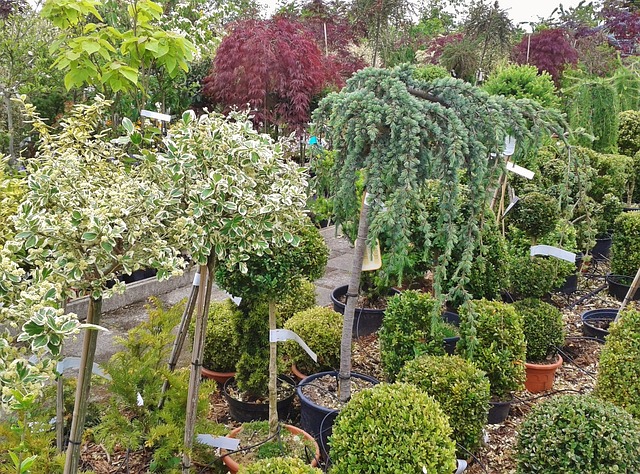
Box is a popular evergreen shrub with small, fresh evergreen leaves that bring a sense of year-round freshness to the garden. It can be clipped into topiary shapes, such as balls, mounds, cones, spirals, or even animals. Alternatively, grow your box play into a low hedge.
Box plants are low-maintenance, making them ideal for lazy gardeners!
However:
Keep an eye out for box tree caterpillar and box blight. If these pests are a concern in your area, you may want to consider alternative evergreens.
Find out how to identify and tackle box caterpillars in our expert guide.
Height x Spread: from 30cm x 30cm
When to Prune Box
The best time to prune a box plant is late spring/early summer once the shrub’s new growth has hardened off.
Avoid pruning during hot, dry weather, as this can stress the plant and increase its susceptibility to pests and diseases.
Check out our experts guide to pruning a box plant.
5. Camellia: Elegant Winter and Early Spring Blooms
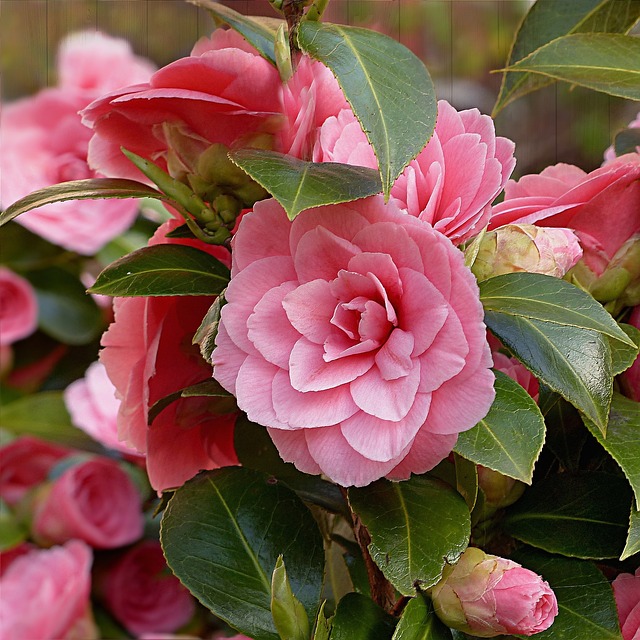
Camellia sinensis is a welcome sight during the late winter and early spring, with its elegant white, pink, or red blooms. However, camellia is the plant that keeps giving, with stunning, glossy, evergreen leaves all-year-round.
Camellias prefer a shady spot with moist, well-drained, acidic soil. Grow them in pots if your soil lacks acidity, using ericaceous compost.
Height x Spread: from 1m x 50cm
When to Prune Camellias
Cut back your camellias right after they finish blooming in late spring. Prune to shape the plant, removing dead or damaged branches, which will encourage bushier growth.
6. Daphne: Winter Blooms and Fragrance

Daphnes are small evergreen shrubs known for their bright, fresh foliage and fragrant winter blooms. Indeed, the strong scent of their flowers can be a delightful surprise during the colder months.
Daphnes are perfect for smaller gardens and thrive in dappled shade, ideally near a path or doorway where their fragrance can be appreciated.
Height x Spread: from 50cm x 50cm
When to Prune Daphnes
To maintain the shape and promote healthy growth, prune daphnes in late spring or early summer after they have finished blooming.
Be careful not to cut back too hard, as this can weaken the plant.
7. Bamboo: A Touch of the Exotic

Bamboo is a striking evergreen shrub that introduces an exotic touch to contemporary or urban gardens, as well as tropical planting schemes. They also make excellent natural screens for creating privacy or concealing unsightly garden features.
Bamboos come in a wide range of sizes and stem colours, from black to yellow, and some varieties can be grown in pots.
But beware: bamboo spreads — literally like wildfire.
So, dig a deep trench around the plant and install an impenetrable barrier to prevent it from going wild. It can even damage your home’s foundations and get inside the house, so introduce bamboo with caution.
Height x Spread: up to 3m x 3m
When to Prune Bamboo
Cut back your bamboo in late winter or early spring. Remove dead, damaged, or overcrowded stems, allowing for new growth and ensuring the plant remains healthy and attractive.
Keep the cuttings and use them to support garden peas, sweet peas, and other trailing plants. 8.
8. Ceanothus: California Lilac
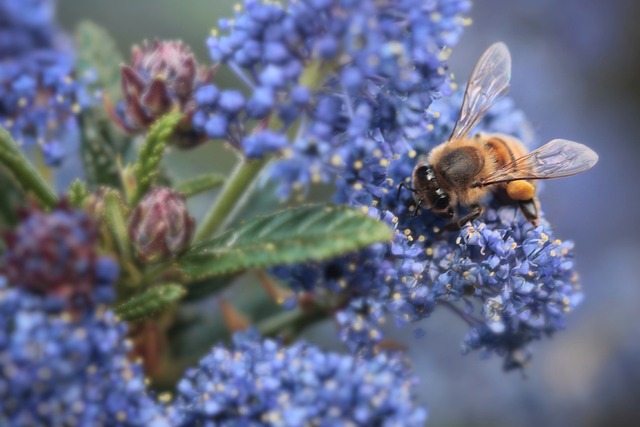
Ceanothus, also known as California lilac, becomes smothered in flowers during May and June, with vivid cornflower blue blooms that are truly eye-catching. You’ll also love the subtle scent — a bit like coca cola.
But be careful when you sniff the blooms because this beautiful bush attracts hundreds of bees! You don’t want one of those lodged up your nostril!
This evergreen shrub prefers a sunny spot but is tolerant of partial shade. Bushy, evergreen types have small, neat leaves and tend to be less hardy, so grow them in a sheltered location away from cold, drying winds.
Height x Spread: from 1.5m x 2m
When to Prune Ceanothus
To maintain the shape and size of your ceanothus, prune it lightly in late spring or early summer after flowering.
Again, be cautious about cutting back too hard, as this could weaken the plant and reduce the number of blooms for the following year.
9. Choisya: Mexican Orange Blossom
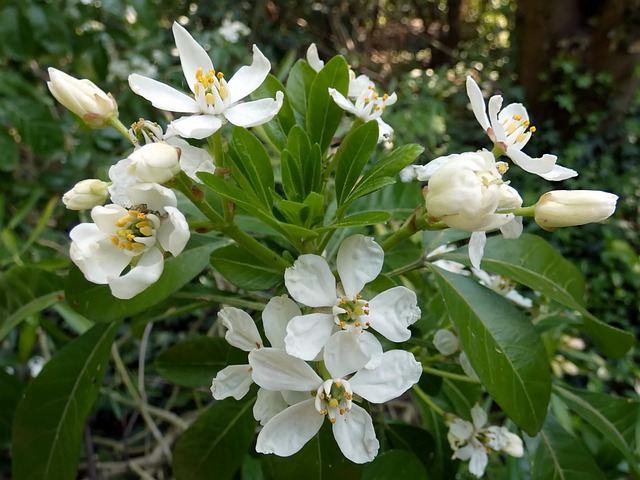
Choisya, or Mexican orange blossom, is a low-maintenance evergreen shrub with glossy green leaves and fragrant white, star-shaped flowers that bloom in late spring and early summer.
This versatile shrub can be grown in full sun or partial shade and is perfect for foundation planting, lining a path, or framing an entrance.
Height x Spread: 3m x 2.5m
When to Prune Choisya
Prune choisya lightly after flowering to maintain its shape and encourage bushier growth.
And like most flowering shrubs, avoid cutting back too hard. This could damage the plant, reducing the abundance of future blooms.
10. Photinia: Vibrant Foliage and Evergreen Structure
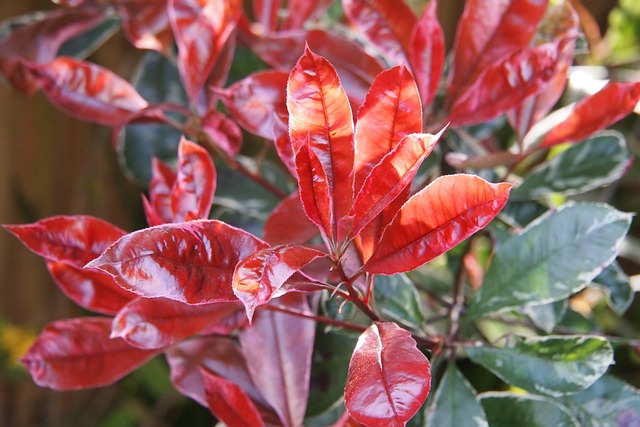
Photinia is a gorgeous evergreen shrub known for its vibrant red new growth in spring, which gradually matures to a stunning deep green.
Grow this versatile plant as a specimen in borders, as a hedge, or in large patio containers.
Photinia x fraseri ‘Red Robin’ is a particularly striking variety that adds a burst of colour to any garden.
Height x Spread: 4m x 4m
When to Prune Photinia
Prune your photinia in late spring/early summer once the plant has finished producing new growth.
This will help maintain the desired shape and size and encourage healthy growth for the upcoming season.
Planting and caring for evergreen shrubs is an enjoyable and rewarding gardening activity that offers year-round interest and colour to your landscape.
Planting and aftercare
These versatile plants not only provide a lush, green backdrop for your garden but also serve as attractive focal points, privacy screens, and windbreaks. With their low-maintenance nature and ability to thrive in various climates, evergreen shrubs are an excellent choice for novice and experienced gardeners alike.
To begin planting evergreen shrubs, selecting the right location in your garden or landscape is essential. Most evergreens prefer well-draining soil and can tolerate a range of sunlight conditions, from full sun to partial shade.
When choosing your shrubs, consider their mature size. Many evergreen shrubs grow big, so make sure they have ample room to grow and spread.
Get planting
Once you’ve selected the perfect spot:
- Dig a hole that’s double the width and as deep as the root ball.
- Gently place the shrub in the hole, ensuring the upper area of the root ball is level with the surrounding soil.
- Backfill the hole using a mix of native soil and organic matter, such as compost or aged manure, to provide your evergreen shrub with essential nutrients.
- Water thoroughly, adding a layer of mulch around the base. This will retain moisture and regulate soil temperature.
Caring for evergreen shrubs
Caring for evergreen shrubs is relatively simple, as they typically require minimal maintenance.
However, regular watering is essential, especially during the first couple of years after planting, to establish a robust root system.
Apply a slow-release, granular fertiliser formulated explicitly for evergreens in the early spring to promote healthy growth and enhance the plant’s overall appearance.
Look out for pests and diseases, and address any issues promptly to ensure the continued health and beauty of your evergreen shrubs.
With proper care, these resilient plants will thrive and provide lasting enjoyment in your garden for years to come.
Choosing the right evergreen shrub for your garden
By incorporating a variety of these evergreen shrubs into your garden, you’ll create a stunning landscape year-round.
Whether you opt for small, compact varieties or large, show-stopping plants, these evergreen shrubs will provide structure, colour, and interest for every season.
However, consider soil type, sunlight, and plant size when selecting the perfect evergreen shrubs for your garden. But with proper care and pruning, these plants will continue to delight and impress for years to come.
FAQs
Bushes that live all year round are known as evergreen shrubs, retaining their foliage throughout the year, providing structure and colour even during winter months. Some popular evergreen shrubs include arborvitae, boxwood, false cypress, holly, juniper, wintercreeper, azalea, and rhododendron.
Beauty is subjective. However, evergreen plants like Hebe, Ceanothus, Camellia, and Aucuba or trees like the strawberry tree, bay tree, and bull bay may also be considered beautiful depending on individual preferences.
Evergreen and coniferous shrubs offer year-round color and interest. Some examples of winter-hardy shrubs are Blue Star Juniper, Boxwood, Ilex aquifolium ‘Myrtifolia Aurea Maculata’, and
Mahonia japonica.
Any questions?
I hope I’ve given you some inspiration for evergreen shrubs to beautify your outdoor space, but if you have any questions, don’t hesitate to get in touch. We’ll get back to you as soon as possible.
And don’t forget: you’ll find most of your answers in our comprehensive Help & Advice section.
Leave a comment
Your answer will be displayed on the site and the interested party will be notified by email.
Leave a comment
Have a question or want to share your experience? Leave us a comment.
Read more
The best tips and tricks for a lush green lawn
 7 MIN
13 Sep
Lavender Cuttings: a step-by-step guide
7 MIN
13 Sep
Lavender Cuttings: a step-by-step guide
 11 MIN
10 Sep
Create Your Low-Maintenance Garden – Tips and Ideas
11 MIN
10 Sep
Create Your Low-Maintenance Garden – Tips and Ideas
 Scarifying Kit
All products after scarifying | Quickly restores the lawn after scarifying | Outsmart weeds quickly with the use of this kit
From: € 39.99
Scarifying Kit
All products after scarifying | Quickly restores the lawn after scarifying | Outsmart weeds quickly with the use of this kit
From: € 39.99
 Spring Lawn Care Kit
MOOWY’s choice for the spring | Quick recovery of your lawn after winter | A strong lawn prevents weeds
From: € 25.99
Spring Lawn Care Kit
MOOWY’s choice for the spring | Quick recovery of your lawn after winter | A strong lawn prevents weeds
From: € 25.99
 Long Lasting Lawn Fertiliser
Effective for 90 days | See results in 14 days! | Suitable for all types of grass and soil
From: € 13.99
Long Lasting Lawn Fertiliser
Effective for 90 days | See results in 14 days! | Suitable for all types of grass and soil
From: € 13.99
Do you want a lawn calendar?
🌱 All important maintenance moments for your lawn during the year. Leave your email and we will send you the lawn calendar for free.
Enter your email
Receive the lawn calendar in the mail
Enjoy a green lawn all year round!










Comments (0)
There are no comments yet. Well then, what are you waiting for to
Be the first to write your comment!inaugurate this pretty page?
Do you have some comments?